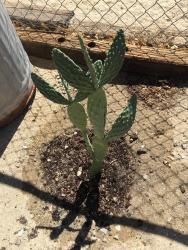Yes, after I transplanted it I didn't pay much attention to it and did a double-take when I actually stopped and noticed how the new pads were different. Should be interesting to see how it develops and whether the next set of pads are linguiformis or not, although I might not find out until next year because the growing season is coming to an end soon.

I think you are correct about it being a reaction to stress from rooting. I had no idea root stress could do that to them. There were two of them in the pot when I bought them and when I went to transplant them a few weeks later, I had to pry the roots apart with a trowel and severed a fair amount of them I imagine. The other one has normal shaped pads interestingly enough, although I don't know if they are clones from the same parent plant or from different ones. Hopefully this one will decide to keep the linguiformis shape.
I know the feeling lol! A house not far from me has a massive O. engelmannii or lindheimeri linguiformis that grows through their gate and nearly into the street. Before I got one myself I would debate every time I went by whether to ask for a cutting or not

